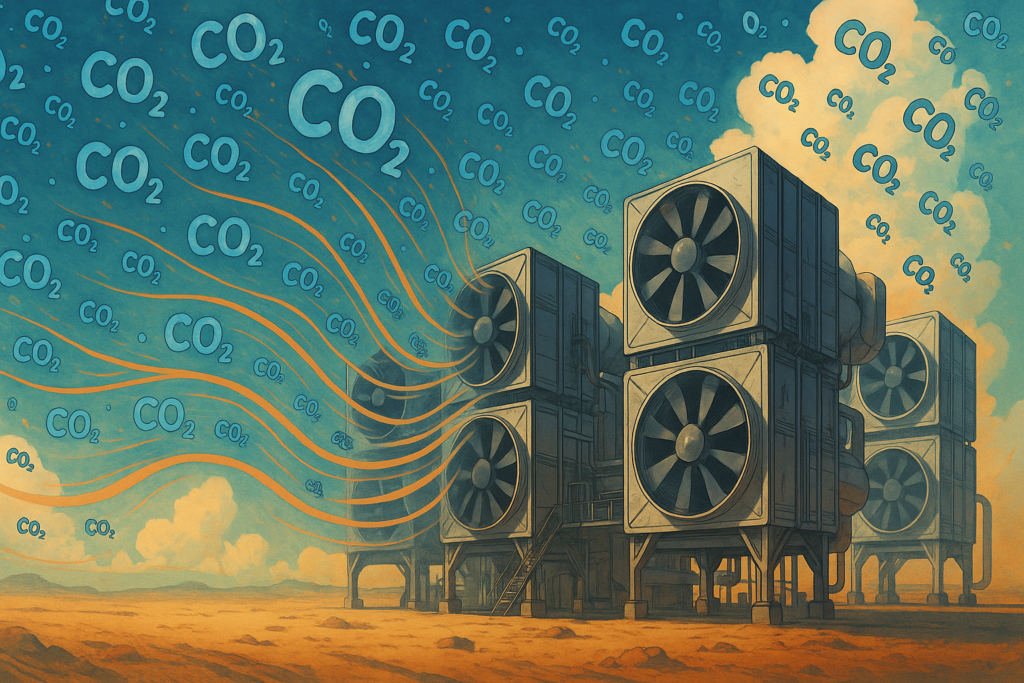Fun Fact: Every year, trees naturally absorb around 2.4 billion tonnes of carbon dioxide (CO₂) — but to truly cool the planet, we need to pull out much, much more!
Introduction: Why Just Cutting Emissions Won’t Save Us Anymore
We’ve heard it a thousand times: “Cut your carbon emissions!” But what if I told you that even if we all swapped our cars for bicycles tomorrow and shut down every coal plant, it still wouldn’t be enough to stop global warming?
Step into the world of carbon dioxide removal (CDR) — a bold new frontier where scientists aren’t just reducing emissions, but actually extracting carbon from the atmosphere to help cool the planet.
In a desperate bid to rescue our future, governments, billionaires, and startups alike are investing billions in three main strategies: pulling carbon directly from the air, enhancing oceans to absorb more carbon, and greening the land to lock carbon away. It’s bold. It’s experimental. And it might just be humanity’s last chance.
The Three Ways We’re Fighting Carbon — and the Clock
Sucking Carbon Directly from the Air: High Stakes, High Costs
Imagine massive machines, scattered across deserts, sucking carbon dioxide right out of the sky like giant air purifiers. That’s not science fiction — it’s real and happening.
Companies like Climeworks (a Swiss firm pioneering carbon capture facilities) and Carbon Engineering (a Canadian company specialising in direct air capture) are building industrial plants that trap CO₂ and store it underground.
In West Texas, Occidental Petroleum (an American oil company diversifying into carbon management) is teaming up with Carbon Engineering to launch what could become the world’s largest direct-air-capture facility, aiming to trap 500,000 tonnes of CO₂ annually.
Problem? It’s breathtakingly expensive — around $600–$1,000 per tonne of CO₂ captured, nearly ten times the cost of carbon credits on the European market!
And just when momentum was building, political winds shifted. Under President Donald Trump, the United States Department of Energy (DOE) froze major funding programs like the $600-million grants promised to these projects. Uncertainty now looms large, and many fear it could cripple this vital sector.
Turning Oceans into Carbon Sponges: The LOC-NESS Experiment
The oceans are Earth’s greatest carbon sink, absorbing about 25% of the carbon we emit. But what if we could supercharge this natural system?
Cue LOC-NESS (Locating and Capturing Oceanic Natural Enhanced Sinks of CO₂), a $10-million U.S. experiment where scientists are literally adding antacids to the Atlantic Ocean to boost its carbon-capturing ability.
Led by geochemist Adam Subhas at the Woods Hole Oceanographic Institution (a prestigious marine science organisation), the project will pour 50 tonnes of sodium hydroxide into the ocean off Massachusetts, aiming to reduce seawater acidity and pull more carbon from the air.
If successful, LOC-NESS could inspire a wave of similar projects globally, potentially removing 1 billion tonnes of CO₂ annually — about 3% of today’s global emissions!
However, tinkering with ocean chemistry is risky. While models suggest minor or positive biological effects, real-world experiments like LOC-NESS are vital to ensure we don’t cause unintended ecological disasters.

Greening the Land: Farming Carbon like Crops
Forests have long been our green guardians, but as climate-driven wildfires rage, we’re learning that trees alone won’t save us. Scientists are now turning to the soil beneath our feet.
One promising technique? Biochar — a charcoal-like substance made by burning organic material in low-oxygen conditions. When added to soil, it locks away carbon for centuries while enhancing soil health.
Another revolutionary idea involves enhanced rock weathering. Researchers like Matthew Kanan at Stanford University (a top-ranked American research university) are cooking minerals like basalt to make them more reactive, helping them absorb CO₂ faster when spread across fields.
And it gets better — energy companies in Denmark and Sweden are planning bioenergy plants that burn agricultural waste, capture the CO₂, and store it underground, preventing it from re-entering the atmosphere.
These land-based techniques could remove up to 17% of the United States’ annual emissions at a cost below $100 per tonne — much cheaper than direct air capture.
Conclusion: Can We Succeed Before It’s Too Late?
The story of carbon dioxide removal is thrilling but filled with peril. We have the technologies. We have the know-how. But political instability, high costs, and ecological risks are real threats. If governments treat carbon removal as a license to delay emissions cuts, we could plunge even deeper into a climate catastrophe.
As Earth-system scientist Wolfgang Lucht warns, “We must act now — not just to cut emissions but also to prevent the next generation from inheriting a mess so large it might be impossible to fix.”
The message is clear: Pulling carbon from the sky is necessary, but cutting emissions must remain the top priority.
If we don’t act with urgency and wisdom, carbon removal could end up being a false hope rather than our saving grace.
Author’s Note
Writing about the future of our planet feels both exciting and sobering. Technologies like LOC-NESS and direct air capture show the brilliance of human innovation, but they also reveal how close we are to the edge. Climate change is not waiting for perfect solutions. It’s here, now. Let’s not wait until it’s too late.
G.C., Ecosociosphere contributor.




